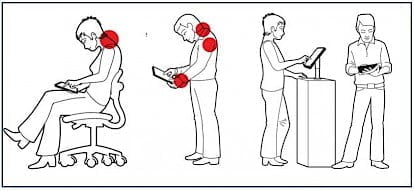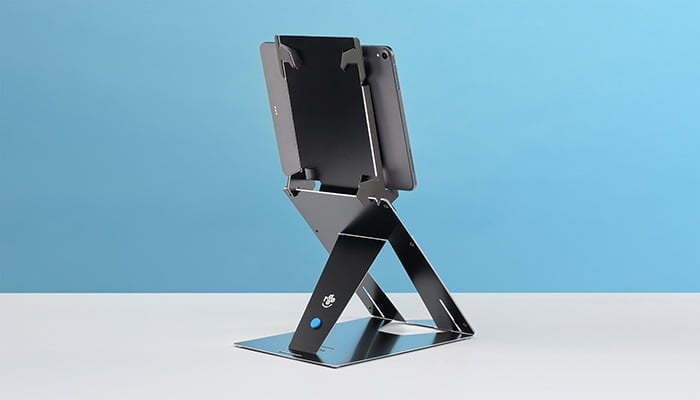With a tablet, any place becomes a workplace. In the train or on the couch, it’s easy to quickly check your document. Flexible working brings so much variety and exercise. Great news, you would think! But there also is a downside: prolonged tablet use creates ergonomic problems. Here you will learn how this arises and what you can do about it.
Low screen, high load
When working with a tablet, the head is bent far forward. The lower the position of the screen, the greater the strain on the neck. In addition, the wrist and hand are in an unnatural position This can quickly lead to neck, wrist and hand strain. In other words: RSI complaints.

Another point that causes strain: holding the tablet. Often, the tablet is held with one hand in a strong pincer grip, while the other hand touches the screen. A tablet may not weigh much, yet the muscle tension in your arm and hand can quickly become too high. With prolonged use, this causes pain.
The readability of the screen also has an impact. Tablets often have a glossy, high-resolution screen. The effect: lots of reflections and small characters. In the long run, this can cause eye complaints and loss of performance. Did you know that you read slower from a screen than from paper anyway?
Watch your tablet behaviour
With these 6 ergonomic tips, you can ensure better posture, high productivity and good readability:
- Maintain an upright posture, keeping the head straight above the body.
- Don’t hold the tablet in your hand or lap.
- Raise the screen and tilt it at least 45° during use.
- Do not use a tablet for more than 30 minutes at a time. So take short breaks regularly.
- When using a tablet for less than 2 hours a day, use a tablet riser, an external keyboard and possibly a mouse.
- For more than 2 hours a day, always use a separate monitor and separate input devices.

Ergonomic aids
There are handy aids that allow you to raise your tablet. At your fixed office workplace, you can opt for a monitor arm with a tablet holder. The advantage of this is that the tablet screen can be placed at eye level. This encourages an upright working posture.
For mobile use, the well-known foldable tablet sleeves are a godsend. The advantage of this is that you always have it with you. For prolonged tablet use (more than 30 minutes at a time), however, a tablet cover is not enough; after all, you still need to look down. That is why there are also tablet stands on the market that allow you to really put the tablet at eye level. These are sometimes even adjustable and easy to carry. Just like a monitor riser, this automatically ensures an upright working position.
So you can work longer on your tablet, although the advice is to keep it to a maximum of 2 hours a day. And for all options: a separate keyboard and possibly a separate mouse will really minimise your risk of RSI complaints.
A proper solution for every screen
You probably don’t just work on your tablet. Want to know more about working with a laptop or a desktop at a fixed workstation? Download our white paper and read all about ergonomic solutions for any kind of screen work.



